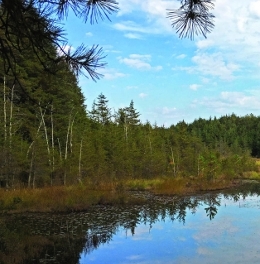
All is fair in love and war—but what about protected natural resources and industrial gains?
The Pinelands have long been the center of many environmental oppositions—today more than ever with the proposal of natural gas pipelines including the South Jersey Gas (SJG) Cape Atlantic Reliability Project, which has become an ongoing saga spurring tensions through our area and a discrepancy between constituents and their representatives.
Ever since its proposal in 2012, the project has been shrouded in political turmoil, protests and court appeals. While its first proposal was turned down by the New Jersey Pinelands Commission, they approved the latest iteration in February 2017, a decision that was kicked back to the Superior Court of New Jersey following legal challenge by various environmental groups.
W hile both sides are awaiting the court’s ruling, the Pinelands remain untouched, a haunting calmness before a potential firestorm that could ignite further opposition. During this waiting period, South Jersey Magazine spoke to both its supporters and opponents about their stance and if this approval opens the door to additional construction within the protected Pinelands.
Understanding the Pinelands
Deep within South Jersey, there are approximately 1.1 million acres that make up the Pinelands National Reserve (PNR)—otherwise known as our nation’s first National Reserve. It occupies 22 percent of our state’s land area, reaching parts of seven counties and is considered the largest body of open space on the Mid-Atlantic seaboard between Richmond and Boston, according to the Pinelands Commission.
Nestled there, is the KirkwoodCohansey water-table aquifer, accounting for an estimated 17 trillion gallons of groundwater, the historic Batsto Village and Wharton State Forest, to name a few. It’s also home to native plants and species—including the Pine Barren Gentian, Thread-leaved Sundew and the Northern Pine Snake—and is known as a world biosphere and UNESCO site.
“The Pinelands [is a] wild place in the middle of the most densely populated state, where you have cranberry bogs, wetlands and cedar swamps that are found nowhere else,” explains Jeff Tittel, senior chapter director of New Jersey Sierra Club. “In a lot of ways, I look at it as our Yellowstone or Yosemite. It’s having this natural area in our backyard where you can go hike, swim, kayak, picnic or fish … literally a half hour from downtown Philadelphia, where people rushing to the Shore don’t realize what a beautiful, natural area [this is].”
As a means of protecting this National Reserve, the Pinelands Comprehensive Management Plan was implemented, with the Pinelands Commission seeing that its rules and land-use guides are followed to both protect the Pinelands’ ecology, while also granting compatible development. This authority was granted following the National Parks and Recreation Act of 1978 and the New Jersey Pinelands Protection Act in 1979.
The Supporters
In the eyes of the supporters, that compatible development includes the Cape Atlantic Reliability Project, a 22mile natural gas pipeline that would run through Atlantic, Cape May and Cumberland counties ending at the B.L. England power plant located at Beesleys Point in Upper Township, Cape May County. There, it would “facilitate the conversion of the facility from coal to natural gas,” according to SJG general manager, public affairs Dan Sperrazza.
This transition from a coal- and oilfired electric generator to a natural gasgenerator would, in turn, make it one of the cleanest power plants in New Jersey, as it would emit lower emissions compared to existing power plants on the grid. It would also enhance the area’s access to safe, reliable energy, cleaner air and cost-effective, locally sourced electricity generation, as noted by Sperrazza.
The promise of cleaner energy has struck a chord with local leaders, including Vicki Clark, president of the Cape May County Chamber of Commerce, who says the conversion of the plant would be “tremendous” to the local environment.
Furthermore, the pipeline would also generate enough energy to power about 480,000 New Jersey homes and would also provide a backup natural gas supply to its customers in Atlantic and Cape May counties—currently about 142,000— and more than 28,000 in the Pinelands in the event of an accident or natural disaster—much like Superstorm Sandy.
“What we saw in Superstorm Sandy was so much salt water intrusion in lines—especially along the coast had suffered storm damage. The amount of time that it takes to restore natural gas service is much longer than other utilities,” explains Clark. “Without a second resource for Cape May County, we could see our area out of natural gas service for months. We see this as a benefit to Cape May County, as a step in preparedness and reliability.”
Reliability is another factor many supporters favor—especially since some parts of Southern New Jersey aren’t in areas where direct energy is easily accessible. “Cape May County is a peninsula, things don’t go through here, they come to here,” says Clark. “I think because of that, we do have to look at this from a little bit of a different lens in terms of reliability and what we need in order to sustain our seasonal economy. If we had experienced the storm damage brought on by Superstorm Sandy as our neighbors to the north, I’m not sure when our tourism economy would have been back up and running.”
As far as the pipeline’s route, Sperrazza notes it would “run parallel to and within rights-of-way of public roads, including New Jersey State Highway Route 49 and New Jersey State Highway Route 50 and the last two miles beneath an already cleared existing power line corridor.”
Construction, he adds, would not require forest cleaning or fragmentation of the Pinelands forest. “A detailed analysis of eight different routes shows that the selected route is, unequivocally, the most environmentally sensitive,” says Sperrazza. “This finding was confirmed by the New Jersey Department of Environmental Protection (DEP), which approved the route in 2015 as the best option from the standpoint of environmental impacts.”
Supported by leaders including Clark, she notes, “I am confident with the route of the pipeline, and it will be installed basically underneath areas that are paved with roadways. Nothing I have seen causes any alarm for the disturbance of the Pinelands or any other pristine areas.
“I have no concerns about the delivery and the use of natural gas,” she adds. “Everything that I see and understand, it is very safe and, of course, we see that with the [worldwide] use of natural gas and its delivery to us. It’s a cleaner and more efficient fuel to use.”
As further support to the project, SJG currently “operates nearly 1,400 miles of natural gas mains and 133 miles of elevated pressure pipelines within the Pinelands, doing so safely, responsibly and without damage to the Pineland resource or to the aquifer beneath it.”
The Opponents
While the Comprehensive Management Plan was instituted to protect the natural state of the Pinelands, some argue it has become a loophole to approve new non-compatible development, like that of Cape Atlantic Reliability Project. In fact, environmental groups, such as Sierra Club, believe the commission was wrong to approve the proposal as it violates that very plan.
“The plan says that when you’re talking about infrastructure like a gas pipeline, it has to primarily serve the needs of the people in the Pinelands,” explains Tittel. “The problem is that the pipeline starts outside of the Pinelands, goes through the Pinelands and ends at a power plant to produce electricity, where that electricity is going to go anywhere and does not primarily serve the needs of the Pinelands.
“Plus, where [the gas line] ends, most of the service area is going to be in Cape May County—outside of the Pinelands. We’re also challenging some other issues dealing with some of the commissioners who voted for it, that they may have conflicts of interest. In the case of one person, who was supposed to represent Camden County, we don’t believe he actually lived in the county at the time he voted in support of the pipeline.”
That opposition is just the tip of the iceberg as the Pinelands Preservation Alliance says the project would run through a conservation zone of the Pinelands, where this type of infrastructure is simply not permitted. “The roads along which South Jersey Gas proposes to build the pipeline run through both residential and forested areas, including public nature preserves,” argues Executive Director Carleton Montgomery.
“According to the plans South Jersey Gas submitted in July 2015, a substantial length of pipeline would run through currently wooded land between houses and the railroad tracks,” he adds. “That will require a new cleared right of way, so not all the length is proposed along roads or other existing cleared land.”
Clean Water Action New Jersey also argues the pipeline will threaten the Kirkwood-Cohansey aquifer, which supplies drinking water to Southern New Jersey. “The pipeline will lie in the aquifer throughout all or most of its length,” explains Montgomery, as supported by a 2017 HydroQuest report.
“SJG does acknowledge it requires some tree cutting along its route. … Unfortunately, the company has been unclear on this point, and has not disclosed any detailed hydrological data, but (a) all horizontal directional drilling sections are far enough underground that they unquestionably will lie within the Kirkwood-Cohansey aquifer, and (b) the water table is generally high in this area, so we expect even the trenched portions of the pipeline will pierce the water table and place the pipeline within the aquifer in much or all of its length.”
While supporters also believe the pipeline would provide both clean energy and jobs, opp onents including Sierra Club believe safer energy alternatives would also promise long-term jobs—without harming the Pinelands.
In light of Gov. Phil Murphy signing an executive order to move the state toward a goal of 3,500 megawatts of offshore wind energy generation by 2030, Tittel believes offshore winds is the best alternative. “The state has been devastated by climate change [and] having more plants that emit greenhouse gases and fueled by fossil fuel makes no sense when we can [do] more [with] renewable energy.
“We would create plenty of jobs in the manufacturing and construction of those windmills—especially the maritime industry—and maintaining them,” rebukes Tittel. “Also, the redevelopment of the B.L. England site … could become a resort [instead of] being a big smoke stack … and that would create jobs, too.
“We just want to have jobs that do not hurt the environment and we want to see appropriate economic growth,” he adds. “We can meet our energy needs through offshore wind, renewable energy and energy-efficiency instead of being addicted to the fossil foolishness of the past.”
What Local Towns Are Saying
Starting in Medford Lakes, which is also located within the Pinelands, borough manager Robert J. Burton explains that while the community embraces its protection, they have not received much feedback about the pipeline—most likely due to the fact that the location is a good distance away.
Burton also adds that “moving to a cleaner energy source in gas, overall provides a more positive impact for the environment than the negatives in running the pipeline. … Solar and wind technology is not yet to the level it needs to be, to be a viable option. Therefore gas is a step in the right direction, although not a perfect one.”
In Tabernacle, residents are served by a mix of natural gas and oil heat, and while residents have submitted requests to SJG for service, the company has been unable to do so per infrastructure limitations. “Tabernacle felt it was necessary to express our high interest in this project because if basic infrastructure—regardless of direct impact—is not able to be constructed, what does that mean for our residents and their future options for affordable natural gas?” asks deputy mayor Stephen V. Lee IV.
“My biggest concern is that many of our homes that were built during the population boom of the 1970s were constructed with underground oil tanks. A s a Pinelands community, I am very concerned about potential leaks with these aging tanks, and look for other energy opportunities like natural gas to not only decrease energy costs for our residents, but protect the environment. On our wooded lots in Tabernacle, and even surrounding areas, solar is not an option unless trees produce sunlight.”
Lee, whose family has been growing cranberries in the Pinelands since 1868, adds, “As a Pinelands farmer, I can personally attest to the challenges we have experienced in operating within the region. Interestingly enough, a primary reason that the Pinelands are so pristine is because of its people that live on and work the land.”
Further out in Cape May County, Clark notes the community—including businesses and consumers—has been overwhelmingly supportive about the project. “The fact that we are such a great destination for people who move here—specifically because of the natural beauty and resources that we have here—says a lot about the confidence in this project. Even though we tend to be a little more environmentally concerned, the popular opinion, as I have seen it, is to be in favor of this project.”
The Case of the Slippery Slope
As both sides await the court’s ruling, it’s worth asking: What does it mean for the future and does it set the precedent for the industrialization of the Pinelands? Looking at New Jersey as a whole, there’s also the New Jersey Natural Gas Southern Reliability Link, a 30-mile natural gas pipeline planning to run through Burlington, Monmouth and Ocean counties. In Central Jersey, there’s the proposed PennEast pipeline that would cross the Delaware Wild and Scenic River, in addition to more than 3,000 acres of preserved lands. Out in North Jersey, there’s the proposed Pilgrim Pipeline, which would cut through the Highlands, several major drinking water sources and the Great Swamp National Wildlife Refuge. What’s more, President Donald Trump has also proposed oil drilling along the Jersey Shore and the rest of the Atlantic coast.
“Exactly the same rationale being used to approve a gas pipeline running from west to east across the Pinelands, would apply to an oil pipeline running from east to west across the Pinelands,” says Montgomery. “The rationale the Pinelands Commission has adopted now and that’s on appeal could be used word for word to approve exactly that kind of pipeline and to us that shows why this reading is so wrong and dangerous to the future.”
Others believe the pipeline would instead be a step forward as it would give South Jersey residents the service and infrastructure improvements they need. “As an elected official, I recognize this need on behalf of our community,” says Lee. “Those that ignore this need are simply ignoring their constituents. Are we supposed to have less access to basic utilities just because we live in the Pinelands?”
Clark shares the sentiment, noting that despite the Comprehensive Management Plan argument, the pipeline would be benefiting Cape May, which is a part of the Pinelands. “I am very sensitive to the concerns of the Pinelands, but I do not believe that this proposal, in any way, endangers the sustainability of the Pinelands and I do not think it opens up a way for other development to take place. … It’s coming to service Cape May County [and] it is an investment when you can provide reliability and sustainability to a part of the service area [and] also look to fulfill those human and business needs.”
What’s Next?
It’s no surprise that the Pinelands is and has been continually eyed for commercial and industrial development. Its pristine land has always been desired, just as American writer John McPhee explained in his 1968 book, The Pine Barrens; “At the rate of a few hundred yards or even a mile or so each year, the perimeter of the pines contracts.”
Some could say this moment in Pinelands history is reminiscent of the late 1950s, when the idea of a Pinelands jetport was considered. While it was defeated in 1969 thanks to Gov. William T. Cahill, the controversy stands as an eerie reminder of what could have been.
“If that had happened, the surrounding area would look like the surrounding area of Kennedy International Airport,” says Clean Water Action New Jersey’s Board Chair Janet Tauro, adding, “[The Pinelands are] a world biosphere and once it’s gone, it’s gone. A pipeline here and a pipeline there, pretty soon you don’t have anything. You can’t keep chipping away; if you keep chipping away, you’re left with nothing.”
While the Pinelands Commission has been unable to comment on the matter since it’s currently in litigation, both sides are preparing for a resolution. A resolution that may be in favor of protecting the Pinelands or of providing its inhabitants with a clean, reliable energy service. Perhaps there can be a resolution that caters to both sides, wishful thinking even as Gov. Murphy’s new administration takes the reins. Either way, it’s clear supporters and opponents want to create the best possible option that will benefit both the Pines and its residents—but at what cost?
Published (and copyrighted) in South Jersey Magazine, Volume 14, Issue 12 (March 2018).
For more info on South Jersey Magazine, click here.
To subscribe to South Jersey Magazine, click here.
To advertise in South Jersey Magazine, click here.












